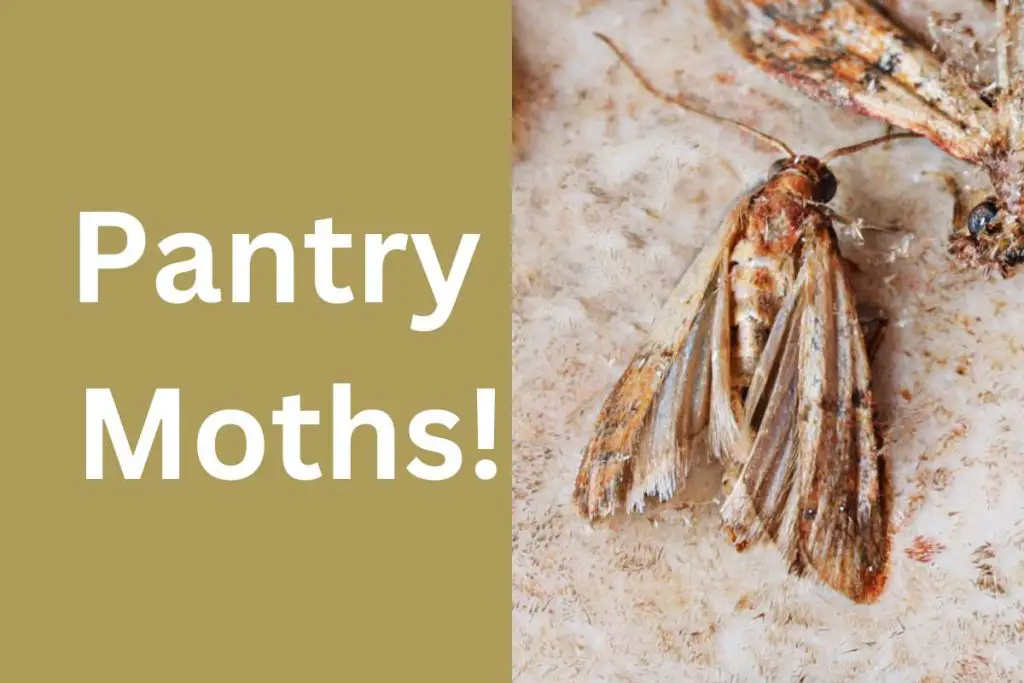It’s every homeowner’s nightmare – you innocently open your pantry for a late-night snack, and out of the corner of your eye, you spot it – a pantry moth. Suddenly, all those late-night snacks don’t seem so appetizing anymore!
Pantry moths are pesky little critters that like to invade homes in search of food and a place to lay their eggs. But did you know those pantry moths are attracted by more than just the food in your pantry?
In this article, we’ll explore what attracts pantry moths, the facts about pantry moth infestations, and some tips on how to prevent pantry moth infestations.
Stick with us as we explore the world of pantry moths and learn how to keep them out of our homes!

Pantry Moths: At a Glance
Pantry moths, also known as Indian meal moths, are small, tan-colored moths that typically measure about one-half inch in length. They have a distinctive pattern of markings on their wings – two silvery gray bands near the top and bottom edges and a coppery brown band in the middle.
Pantry moths lay hundreds of tiny eggs, which hatch into larvae or caterpillars. The larvae feed on grains, dried fruit, cereals, nuts, and other pantry items. As they feed and grow, the larvae spin silken webs that can be found in cracks and crevices of your pantry shelves.
If left untreated, these moths can quickly multiply and create an infestation in your pantry.
What Attracts Pantry Moths: The Culprits
So, why do pantry moths enter our homes in the first place?
The short answer is food. Pantry moths are attracted to grains, cereals, nuts, dried fruits, and other high-protein items. They can also be attracted by spilled food particles and other food residue found in hard-to-reach places like cracks, crevices, and corners of your pantry shelves.
But that’s not all! Pantry moths are also attracted to pet food, birdseed, and even dirty dishes left in the sink!
According to the National Pesticide Information Center, pantry moths can also be attracted to infested items that you bring into your home – like flour, cereal, or birdseed. So while it’s tempting to buy in bulk, it pays to inspect any items before bringing them into your pantry.
The tiny caterpillars, or larvae, are the main damage-doers. They can feed on various food items, including grains, cereals, nuts, and dried fruit. What’s concerning is that larvae can chew through thin cardboard and plastic packaging, making them a force to be reckoned with!
Preventing Pantry Moth Infestations: Tips & Tricks
Now that we know what attracts pantry moths let’s explore some tips and tricks on how to prevent them from entering your home in the first place.
Use Thickly-Walled Plastic Containers
Opt for thickly-walled plastic containers to store food items in your pantry. Not only will this make it harder for pantry moths to chew through packaging, but it will also help keep food items fresh for longer.
Make sure you use glass or hard plastic containers that are air-tight. This will help keep pantry moths from entering your pantry in search of food.
If you have any items in cardboard or paper packaging, consider transferring them to a plastic container.

Regularly Clean Your Pantry Shelves
Cleanliness is key when it comes to preventing pantry moth infestations. Empty your pantry shelves every few weeks and vacuum or wipe up any food particles. Wipe down the shelves with a damp cloth or all-purpose cleaner, being sure to get into tight corners and crevices.
Also, inspect items for signs of infestation, like webbing or moths, before bringing them into your pantry.
Make sure also to vacuum the area around your pantry regularly. This will help get rid of any food particles that may have accumulated over time.
Use Cloves or Mint to Repel Pantry Moths
If you already have an infestation, there are a few things that you can do to get rid of pantry moths. Sprinkling a few cloves or mint leaves around the perimeter of your pantry shelves can help repel pantry moths, as they dislike the scent.
Insects, such as pantry moths, don’t like the smell of certain herbal oils. Try adding a few drops of clove, mint, eucalyptus, or cedarwood essential oil to a cotton ball and placing it on your pantry shelves.
You could also try using pheromone traps (link to Amazon) to catch adult moths and break their mating cycle. Pheromone traps come in various sizes and are designed to lure adult moths with the scent of pheromones without using dangerous pesticides.
Use Older Food First
Make sure that you follow the “first in, first out” rule when it comes to food. This means using older items before opening new ones.
That way, if an infestation does occur, you can isolate the affected item and get rid of it before it has a chance to spread to other foods. Since pantry moths can lay up to 400 eggs at a time, it pays to stay on top of your food storage.
You can also transfer some of the older food items to the freezer for a few days. This will provide an added layer of protection in case any eggs have been laid inside the food.
Don’t Forget Your Shelf Liners
Got paper shelf liners in your pantry? Throw them out and replace them with plastic or foil-lined ones. Pantry moths can easily chew through paper shelf liners, giving them easy access to your food items.
The plastic and foil-lined liners can provide an extra layer of protection against pantry moth infestations, as moths cannot chew through them. Make sure to replace the liners regularly for maximum effectiveness.
Conclusion
Pantry moths can quickly become a nuisance if left unaddressed. No one wants pantry moths in their home, so taking the time to understand what attracts them and how to prevent an infestation is essential.
By following these tips and tricks, you’ll be able to keep pantry moths away for good!
Recommended Reading:
- How to Store Bread To Maintain Freshness (Best Practices)
- How to Organize Cereal Boxes in the Pantry
- How Long Do Potatoes Last In The Pantry?
Declutter your home once and for all (Even if you have no time and don't know where to begin)! Learn More.
